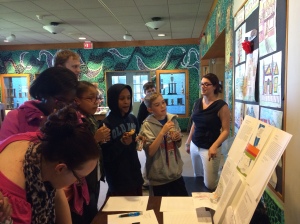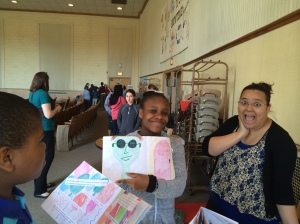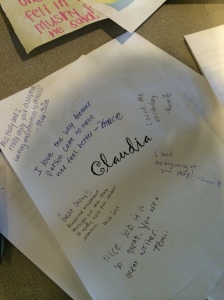This week, my pre-service teachers celebrated the end of their “writing workshop” fieldwork experience with an authors celebration of their fifth graders’ writing. The middle school halls were lined with tables full of poetry, short stories, and magazines. Kids strolled around reading each others’ work and writing endearing messages on comment sheets that the student-authors would later take home to show off to parents and siblings.
There were smiles all around – proud students and their (pre-service) teachers. One student that had refused to write a word for several weeks, hurriedly flipped through his group’s publication looking for his short piece, and when he found it he whooped loudly in the air with joy, and then sighed with relief in finding it was there. Inside I was thinking, “I predicted that scene from the start.”
Yet many of my pre-service teachers did not yet have the faith to believe that the semester would end in such a joyous celebration. I remember several moments of tears and anxiety in which my students felt all was lost: their students disliked them, or didn’t want to write, or just wouldn’t listen. “It’s part of the process” I would say, and, “have faith, things will work out – just not how you think they will.” I realize now that those statements can be easily misunderstood without more articulate explanation.
It all starts with intentional practice and craft. The foundation of “the process” is rooted in a strong pedagogical praxis (beliefs+actions). A pedagogical praxis should be informed by student-centered learning theory and guided by social justice principles. The purpose of teacher education is (or should be) to help individuals develop such a praxis.
As we all know, one-size does not fit all, and one method may work in some circumstances both not in others. However, a pedagogical praxis goes deeper than method. It is akin to a faith – a system of beliefs and practices that guide you in making the most ethical and informed decisions possible. It takes a lot of self-reflection to develop this praxis, and even more reflection when using it to make teaching decisions.
“Trusting the process” is not about having blind faith in a method. It is about having faith in the small moments that your pedagogical praxis will help you make the right decision, toward the best end possible. Even with the best laid plans, we never really know what’s going to happen tomorrow, or the next second, or the next minute. All we can do is make the best decision in the moment we are given. This takes mindfulness, and a strong, articulate pedagogical praxis. Have faith in a single method, and you will undoubtedly be disappointed; have faith in your pedagogic praxis, and wherever you end up, you will know the outcome will be rooted in a strong pedagogical foundation.
 I see my job as helping pre-service teachers to define their pedagogical praxis and reflect upon how they have used it (or could use it) to make the best decisions when they are teaching. Sure, there are methods to know and try – and I certainly teach many “tools” and specific methods – but it is essential that my students understand how or why they might use these methods to support their praxis, and to develop new or different methods when they need to adapt or change.
I see my job as helping pre-service teachers to define their pedagogical praxis and reflect upon how they have used it (or could use it) to make the best decisions when they are teaching. Sure, there are methods to know and try – and I certainly teach many “tools” and specific methods – but it is essential that my students understand how or why they might use these methods to support their praxis, and to develop new or different methods when they need to adapt or change.
So, learning to “trust the process” is actually about learning to trust oneself, which happens through the process of developing that pedagogic praxis. When we do so, we also develop a healthy confidence. Not a confidence in a one-right-way; that is unhealthy because it is unrealistic and easily shattered. A healthy confidence is when one has faith in themselves in being a problem-solver, maker and tinkerer. They have that confidence because they have faith in their pedagogic praxis.
 I’ll say one last thing about pedagogic praxis. Beliefs about teaching are not developed in isolation. Pedagogic beliefs are developed through relationships with others, such as observing and talking with other educators. While in many cases, this occurs unintentionally (just going along with what others are doing, or what one experienced as a student), teachers can be more intentional about how to develop their pedagogic principles. Furthermore, the most powerful pedagogic praxis is developed when a group of teachers gather with wide-awake intention to reflect upon and develop their praxis together. As the saying goes, “we’re better together.”
I’ll say one last thing about pedagogic praxis. Beliefs about teaching are not developed in isolation. Pedagogic beliefs are developed through relationships with others, such as observing and talking with other educators. While in many cases, this occurs unintentionally (just going along with what others are doing, or what one experienced as a student), teachers can be more intentional about how to develop their pedagogic principles. Furthermore, the most powerful pedagogic praxis is developed when a group of teachers gather with wide-awake intention to reflect upon and develop their praxis together. As the saying goes, “we’re better together.”



Pingback: Sunday Salon: A Round-up of Online Reading | the dirigible plum